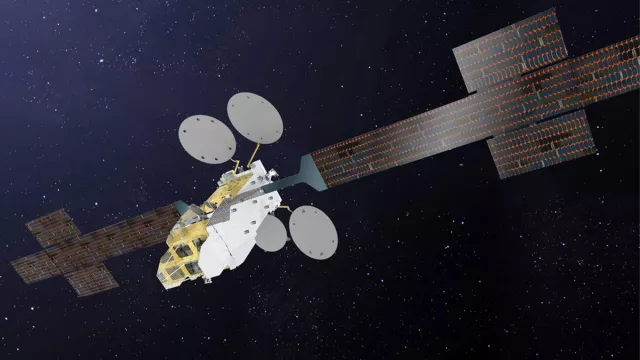The GEICO project (for GEneric technology for Innovation and COmpetitiveness) is supporting development of equipment and technologies made in France for satellites delivering television broadcast and multimedia connection services. It thus falls within the remit of CNES’s mission to boost the competitiveness of French industry.
Key information
| Mission | Sustain the competitiveness of the French telecommunications satellite equipment industry |
|---|---|
| Domain | Telecoms, navigation |
| Start date | 2013 |
| Partners | Thales Alenia Space, ArianeGroup Satellite, MECANO ID, Thales AVS, RAKON |
| Where | Geostationary orbit |
| Lifetime | Indefinite |
| Status | In development |
Key milestones
- December 2024: Detailed Design Review of master reference oscillator product line (RAKON, TRL 6)
- December 2023: SPRINT reflectors (ArianeGroup) qualified and first flight models delivered (TRL 7)
- November 2022: Final review of “waveguide harness competitiveness” activity (Thales Alenia Space, TRL 5-6)
- November 2021: Preliminary Definition Review of multiple-feed gateway antenna product line (Thales Alenia Space, TRL 5)
- February 2021: Ka-band 250-W amplification tubes qualified (Thales AVS, TRL 7)
- December 2019: RF-to-PCB conversion chains (Thales Alenia Space) for VHTS PNT transparent digital processor qualified (TRL 7)
- November 2019: Detailed Design Review of Ku-band multi-beam feed unit (Thales Alenia Space, TRL 6)
- July 2018: Preliminary Definition Review of Earth-facing antenna module product line (Thales Alenia Space, TRL 5)
- July 2014: Detailed Design Review of C-band compact exciters (Thales Alenia Space, TRL 6)
Project in brief
Operating in geostationary Earth orbit, most telecommunications satellites broadcast television and/or provide two-way communications links, for example for Internet services. To this end, they have:
- antennas on their Earth-facing and lateral sides to receive signals from the ground (uplink) and relay them to users (downlink)
- repeaters (also called transponders) to amplify received signals by a factor of 109 to 1,012 and convert output frequencies in order to avert interference between uplink and downlink signals
- and sometimes a digital processor—built into the repeater—to alter signals or how they are allocated between the uplink and downlink
The goal of the GEICO project launched in 2013 is to support improvement of such equipment and technologies developed by French industry. It is concentrating on the core range of telecommunications satellites used to broadcast television and provide communications at medium data rates in C, Ku and Ka bands. GEICO complements the THD-Sat project focused on developing technology building blocks for fast-broadband Internet services, the FLIP and FAST projects, and the NEOSAT project to conceive a new-generation bus for telecommunications satellites.
CNES’s role
GEICO activities are defined jointly by CNES and industry. They cover antennas, repeaters and methods (simulation software, assembly and test methods, etc.), as well as cross-cutting technologies and payload architecture. Development work is carried out and co-funded by manufacturers. The project initially aimed to bring products to commercial maturity and, if possible, ready them for in-orbit operations before end 2020.
Contacts
Project Leader
Frédéric Lacoste
E-mail: frederic.lacoste at cnes.fr
Head of Telecoms & Navigation
Jean-Philippe Taisant
E-mail: jean-philippe.taisant at cnes.fr


